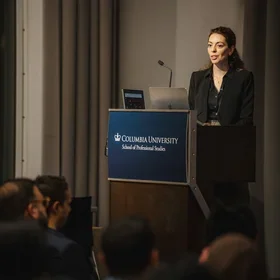By Dr. Steven Cohen, Senior Vice Dean, School of Professional Studies; Professor in the Practice of Public Affairs, School of International and Public Affairs
The New York Times has undertaken an excellent and comprehensive study of America’s groundwater resources. According to a report last week by Dionne Searcey and Delger Erdenesanaa:
“America’s stewardship of one of its most precious resources, groundwater, relies on a patchwork of state and local rules so lax and outdated that in many places oversight is all but nonexistent, a New York Times analysis has found. The majority of states don’t know how many wells they have, the analysis revealed. Many have incomplete records of older wells, including some that pump large volumes of water, and many states don’t register the millions of household wells that dot the country… For generations, groundwater regulations around the country were routinely based on legal principles or economic forces that prioritized the needs of the moment, like farming and ranching in the West, or urban expansion in Eastern states… There is no shortage of rules. In fact, states have created such a tangle of regulations that it can be difficult to understand how much water is being extracted from aquifers, complicating the efforts to protect them.”
This basic resource is endangered, while at the same, time anti-regulatory forces dominating the fringe of the Republican-controlled House of Representatives are working to cut EPA’s budget and shut down the government due to their perception that public administration is not important. Groundwater contamination is not a new issue, but it rarely attracts attention. This is because even though it is a critical resource, it is not visible to the naked eye. It is buried underground. Here, in New York City, our original ecosystems featured plentiful groundwater resources that we completely destroyed as the city’s development moved north from lower Manhattan. The result was the construction of reservoirs. including one located where Bryant Park sits today, another in Central Park, and finally, today’s multi-billion-dollar engineering marvel that includes a system of reservoirs in the Croton and Delaware watersheds north of the city.
In our case, groundwater destruction was the price we paid for the density of development we wanted, but that density created the wealth required to generate the tax revenues needed to build and now maintain our water system. I doubt the rest of the country wants to imitate New York City’s population density or tax burden. But unwittingly, the anti-tax and anti-regulatory zealots that dominate some of our state and local governments may eventually have to pay cash to purify water that today is filtered by environmental services provided by natural ecosystems. Destroy the ecosystems, over-pump the groundwater, and before you know it, you are digging reservoirs and spending billions of dollars to filter and treat water to get rid of all the chemical contaminants you’ve allowed to pollute this essential resource.
Water, like air, is not an optional resource for our species. And dirty air and water make humans sick and can kill us. So, today’s anti-regulatory advocates will be leaving expensive water bills as a legacy to their children and grandchildren.
The New York Times’ report provides examples of weak and understaffed state agencies regulating groundwater. Many states do not know the number of wells that are pumping water from aquifers within their borders. Population growth and increased economic activity lead to the increased use of these resources. The great danger is that by over-pumping, aquifers that feed groundwater sources can run dry. Climate change has altered weather patterns, and communities that once had little groundwater may have over-supply, and places that once had lots of supply are now suffering from drought conditions. The lack of information and organizational capacity are indicators of America’s weak ability to manage this increasingly threatened resource.
I anticipate that water scarcity and water quality issues will reach crisis levels in localities all over America in the next several decades. Like the groundwater in Manhattan, some of the damage will be irreversible and will require billions of dollars of infrastructure construction. In other cases, ecosystem restoration, investment in filtration plants, and construction of public water systems may enable continued use of groundwater resources. The sad fact is that an active program of data collection and remedial measures today could save billions of dollars in the future, but local politics and the economic and political power of those currently over-using groundwater makes it unlikely that these resources can be protected adequately. Aquifers are recharged by rainwater, but if recharge zones are paved over, the rain may never reach the places they need to get to replenish the groundwater.
It is a pure case of the “tragedy of the commons,” where it is in everyone’s self-interest to overuse a free common resource until we so overuse it that it is destroyed. The New York Times’ study is an important effort to enhance our understanding of the issue, and I am certain that there are many state and local officials who worry about current trends. In today’s U.S. Congress, there is no chance that a national policy to promote groundwater protection could be enacted. Since water supply is largely a local issue, the locus of any policies that protect groundwater would be at the state and local levels. The federal government could provide expertise and funds, but not with the current congress. The objective environmental conditions that localities will be confronted with will be reduced supply and contaminated water. In most cases, these conditions will deteriorate gradually, and prevention will require a forward-facing government that can act on trend lines. Some will manage to accomplish this, others will not, but communities cannot exist without water. Homeowners may be confronted with the choice of radical increases in water taxes or radical decreases in their home equity. While I might sound alarmist to some, the impact of water supply on housing is already being experienced.
Communities in Arizona that have inadequate water supply are starting to restrict land use development. In a New York Times piece this past June, Christopher Flavelle and Jack Healy reported that:
“Arizona has determined that there is not enough groundwater for all of the housing construction that has already been approved in the Phoenix area, and will stop developers from building some new subdivisions, a sign of looming trouble in the West and other places where overuse, drought and climate change are straining water supplies. The decision by state officials very likely means the beginning of the end to the explosive development that has made the Phoenix area the fastest growing metropolitan region in the country. The state said it would not revoke building permits that have already been issued and is instead counting on new water conservation measures and alternative sources to produce the water necessary for housing developments that have already been approved.”
The American idea that resources are infinite and the market can be totally free is running directly into the limits of local water supply. It is not that we are running out of water. The planet has the same amount of water that it has had throughout human existence. However, some has been polluted, some has been contaminated by salt water, and people have moved away from places with plenty of water to places that have limited supplies. The land may be cheaper in Arizona, and the building regulations may be less stringent, but without water, none of that matters.
Most of America is not a desert, and with adequate infrastructure investment, water can be transported over thousands of miles to meet people’s needs. But that costs money, and the era of clean and free groundwater supply is likely coming to an end. Groundwater could be protected with adequate planning and governance, but it will likely fall victim to short-term thinking, greed, and under-regulation. The future of America’s water supply is an open question. The need for an adequate water supply is not open to question.
Views and opinions expressed here are those of the authors and do not necessarily reflect the official position of the Columbia Climate School, Earth Institute, or Columbia University.



